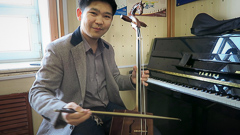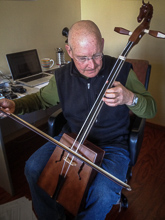Morin Khuur

Munkhjin, Demonstrating
Of the many unusual musical instruments here, the most cherished is the Morin Khuur, an out-of-square soundbox that is perched between the knees, connected to a carved horse's head by a long neck that stretches a pair of horsehair strings. (F, B♭) It is held upright, something like a cello, which in my ignorance, I thought might give me an advantage. If so, I did not get much of a head start. My instructor, son of one of Mongolia's most celebrated musicians and teachers, went with me to choose an instrument, and after testing four and eliminating them one by one, he finally stood up and passed his choice to me. "En" he said as he nodded, passing it and the bow to me so I could pay for them. "This."
When I got home I took it out of its satin bag, sat down, and tried to play a few notes. Although I have seen them played by Mongolians on horseback, so offensive was the best sound I could make with it that I was convinced I had broken mine carrying it home from the music store. Twenty minutes earlier, in Munkhjin's hands, it had made the most magical music you have ever heard. Now it was a way to torture neighbors who had been celebrating a birthday for most of the night.

Working Out Some Details
Right now, I've been working at it for about three months, and though my teacher, Munkhjin, has missed the last few lessons I've continued to make progress, carving off a new piece of a song, pushing back the upper range of what are notes and what are just squeals. I have a few simple songs under my belt, and as with all music, there is room for improvement in even the simplest task. During the first week of July there is an International Morin Khuur Festival, with players coming from several countries in the central Asia region. At least one, though, has been invited from the United States. Don't expect him to win any awards, but he is quite honored to be considered.